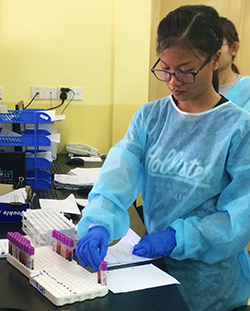 Laboratory staff conducting TASER-2 study tests at the National Center for HIV/AIDS, Dermatology and STD, Phnom Penh, Cambodia, September 2016. While greater access to antiretroviral therapy (ART) has made HIV a manageable disease for more people, HIV can become resistant to antiretroviral drugs, making them less effective in controlling the virus, which allows it to replicate. This condition is called virologic failure, and is often a result of poor treatment adherence. In people with virologic failure, HIV drug resistance can develop, and some classes of HIV drugs are more likely than others to be associated with resistance.
Laboratory staff conducting TASER-2 study tests at the National Center for HIV/AIDS, Dermatology and STD, Phnom Penh, Cambodia, September 2016. While greater access to antiretroviral therapy (ART) has made HIV a manageable disease for more people, HIV can become resistant to antiretroviral drugs, making them less effective in controlling the virus, which allows it to replicate. This condition is called virologic failure, and is often a result of poor treatment adherence. In people with virologic failure, HIV drug resistance can develop, and some classes of HIV drugs are more likely than others to be associated with resistance.
In its 2017 report on global HIV drug resistance, the WHO states that minimizing the emergence and transmission of HIV drug resistance is essential to achieving and sustaining “the last 90” target—having 90% of people on HIV treatment virally suppressed with undetectable viral load tests. It estimates that if current prescribing patterns continue, HIV drug resistance may rise to a level that imperils the global targets to end AIDS as a public health threat by 2030.1
When resistance to first-line treatment occurs, patients can be switched to a second-line treatment regimen with different available drugs. But patients can fail their second-line treatment as well.
To better assess viral failure and associated HIV drug resistance in HIV-infected adults on second-line ART, enrollment for the TREAT Asia Study to Evaluate Resistance 2 (TASER-2) began in 2016. The study is funded by ViiV Healthcare and the US National Institutes of Health through the IeDEA global cohort consortium.
 (Left to right) Mr. Yun-Ting Chan, Ms. Tor Petersen, Dr. Jeremy Ross, and Dr. Man Po Lee at the Queen Elizabeth Hospital, Hong Kong, during a TASER-2 site visit. May 2017.Over 2,400 participants were enrolled in the study across 12 participating sites in Cambodia, Hong Kong SAR, India, Indonesia, Japan, Malaysia, the Philippines, Singapore, South Korea, and Vietnam.
(Left to right) Mr. Yun-Ting Chan, Ms. Tor Petersen, Dr. Jeremy Ross, and Dr. Man Po Lee at the Queen Elizabeth Hospital, Hong Kong, during a TASER-2 site visit. May 2017.Over 2,400 participants were enrolled in the study across 12 participating sites in Cambodia, Hong Kong SAR, India, Indonesia, Japan, Malaysia, the Philippines, Singapore, South Korea, and Vietnam.
Preliminary data show that among 1,505 eligible participants, 7.4% were confirmed to have virologic failure, defined as having two consecutive viral load tests over 1000 copies/ml while on second-line treatment. Among those with virologic failure, 33% had at least one resistance mutation to nucleoside reverse transcriptase inhibitors, 12% were resistant to non-nucleoside reverse transcriptase inhibitors, 3% were resistant to protease inhibitors, and 3% were resistant to integrase inhibitors.
Detailed study analyses on the prevalence of virologic failure, associated factors, and HIV drug resistance mutations will be completed later in the year.
“With more detailed information about levels of resistance to second-line antiretroviral therapies, and which drugs are most vulnerable to resistance mutations, we will be better able to predict the need for third-line ART regimens in the region,” said Dr. Jeremy Ross, Director of Research for TREAT Asia and project leader of TASER-2.
“A stronger evidence base of data from within the region will also facilitate advocacy efforts for inclusion of third-line options in national treatment guidelines and expansion of routine viral load testing capacities in the region,” he added.
1 World Health Organization. WHO HIV Drug Resistance Report 2017. Available at: http://apps.who.int/iris/bitstream/handle/10665/255896/9789241512831-eng.pdf;jsessionid=0C242102CE4DA8A4A99BE6662F519C46?sequence=1